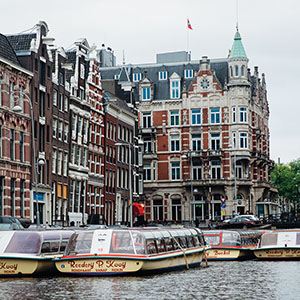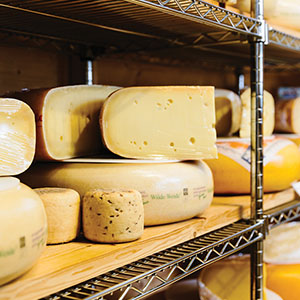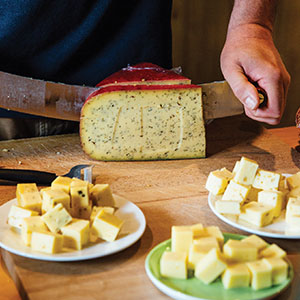Gouda From The Netherlands is one of the world’s most popular cheeses, and one of Holland’s most renowned exports. It’s also a huge category that encompasses many styles, from artisanally-produced farmhouse cheeses to factory-made wheels. The format of Gouda can be small, gigantic or somewhere in between. Wheels can be crafted with cow, sheep or goat’s milk. For a cheese with such truly diverse varieties, one thing is consistent when it comes to Gouda—it’s a true crowd-pleaser. Kids, grownups, cheese lovers and devoted curd nerds seem to agree that this cheese is often fantastic and definitely craveable.

A Long and Storied History
In the Netherlands, archeologists have discovered equipment for producing cheese that dates back to 200 BC. That’s over 2,000 years of cheesemaking tradition. Over centuries, the Dutch have become experts in the field. The classic cheese Gouda, with its characteristic sweetness and notes of caramel, has been made since at least 1184, making it one of the oldest recorded cheeses still being crafted today.
Cheese starts with milk, and milk begins with livestock. Holland’s abundant green grasses and mild temperatures make it an ideal environment for cows, which graze on the country’s lush pastures. A drive through the Dutch countryside will be replete with herds of bovines out the window, happily munching away.
Gouda is named after a town in southern Holland—the town where the cheese was distributed, not where it was made. In the Middle Ages, certain municipalities held exclusive rights to weigh and sell cheese. Gouda was one of these towns, as was Edam, another Dutch city and cheese. Gouda fast became a hub for cheesemakers and farmers to bring their wares, where the cheese would be weighed and sold in the town square. The tradition still continues to this day on Thursday mornings during the summer months, when wheels of Gouda wrapped in wax rinds are proudly displayed on the city’s ancient cobblestones.
It bears mentioning that the name “Gouda” is not protected under European or international law. There are a number of high-quality American cheese made with a Gouda-style recipe, but for the purpose of this article, we’re going to solely focus on Dutch Gouda.

A Perfect Environment
Holland contains 280 miles of coastline along the North Sea and the mouths of three important European rivers—the Rhine, Schelde and Meuse. Since around 400 BCE, the Frisians, who were the first to settle the Netherlands, built terpens (villages on raised land) and dikes to try to control flooding. On December 14, 1287, the dikes that held back the North Sea failed. Known as the St. Lucia’s Flood, monstrous waters killed over 50,000 people. The event was one of the worst floods in history.
In the centuries that followed, the Dutch worked to control flood waters that could easily spell destruction. The Dutch developed the polder system, “whereby they enclosed their fields with dikes and then pumped out surface water to create permanent dry lands,” explains Paul S. Kindstedt in Cheese and Culture: A History of Cheese and Its Place in Western Civilization. A system of windmills helped to remove water from the polder. “Between 1350 and 1500, the production of cheese and butter rose steadily, finding strong markets in the nearby urban centers that were growing rapidly and prospering through maritime trade.” Holland’s economy continued to flourish through 1700 and beyond, and dairy farms grew as the demand for Dutch cheese kept growing.
The Dutch created a product that was meant to be popular in the European marketplace—and it was. By scalding the pressed and salted cheeses in hot whey, they made a smooth rind that would look appealing to buyers. They dyed wheels with linen cloth soaked in turnsole, a dye that had been used for manuscripts since Medieval times that gave their cheese a distinctive purple hue. It was visually catchy and had the added benefit of repelling insects and maggots.
Gouda wheels were 15 or 16 pounds at this time, which made them easy to transport on ships. The cheese was pressed in rounded wooden molds. The lower moisture and scalded curds meant the cheese would last on a long journey without rotting. The characteristic step in Gouda making is delactosing, which means washing the curd with hot water that is added to curds while they’re in the vat. The step removes some of the lactic acid, which creates a sweeter cheese and gives Gouda its memorable flavor. Sweet cheese proved incredibly popular in the marketplace. A new bright color—from saffron threads and vinegar—imparted a pretty yellow hue. “Holland went on to become arguably the most industrialized, technology-intensive, specialized and successful cheese-producing country on the planet,” says Kindstedt.

Gouda Today
It’s thanks to that booming industry that supermarket shelves are stocked with all kinds of industrially-produced Gouda. It was at the end of the 20th century when Holland had a renaissance of farmhouse cheesemaking on a smaller scale, inspired by an internationally renewed appreciation for traditional foods.
“The history of farmstead production means every farm would have their own recipe,” says Rachel Juhl, the chief educator and trainer at Brooklyn, NY-based cheese importer Essex St. Cheese. Today, many varieties of Gouda are available in all sorts of styles. “There’s everything from red wax Gouda to extremely old and flavored Goudas,” Juhl adds.
The younger the cheese, the creamier its texture. Graskaas is made from the first spring milking after the cows have left the barn to graze on the first spring grasses and wildflowers of the season. This milk is the creamiest and sweetest of the year, and the resulting cheese is mild, grassy and smooth. Aged for just a month, Graskaas pairs beautifully with fresh vegetables and rose wines.
As it gets older, Gouda acquires a hard, crumbly texture and a sharper, somewhat nuttier taste. With age, the cheese develops crunchy crystals that provide incredible depth and texture. “It was discovered that if Gouda was stored at the right temperature and humidity and turned frequently over two or more years, the cheese became a miracle of flavor,” says Steven Jenkins, author of The Cheese Primer. The result is a “perfumy, Scotch-whisky kind of aroma—both sharp and sweet at the same time, like molten honey or butterscotch.
Essex St. imports Goudas from L’amuse, founded in 1989 by husband and wife team Betty and Martin Koster. They run an Amsterdam operation that features rare, small-production Dutch gems like Wilde Weide and Terschelling. Betty’s deep, long-term connections with Dutch farmers, cheesemakers and opleggers (the Dutch term for affineurs) has given her access to an unparalleled range of cheeses.
Their L’amuse Signature Gouda, made with pasteurized cow’s milk from Holstein Friesians, is aged for more than two years. In that time, it develops well-distributed tyrosine amino acid crystals and roasted hazelnut and caramel notes. Its sweet-salty finish goes on and on. It shines with Bordeaux and Rhône wines, and also with chilled Colheita port.
Wilde Weide Gouda is made by Jan and Roos van Schie on their 300-year-old island farm on the south Holland lake of Zwanburgerpolder. Produced with raw cow’s milk from their Montbeliarde and red Friesian cows, and certified organic by EU, this Gouda is aged for approximately 15 months. Wilde Weide boasts layered flavors of fresh flowers, hazelnut, butter and sweet bourbon.
L’amuse also sources Brabander Goat Gouda, which is made in Brabant, a region in the southern part of Holland, from the milk of Saanen goats. The wheels are hand selected and aged at the Fromagerie L’Amuse in Santpoort-Noord for six to nine months. The snow-white, buttery cheese has a slightly goaty, sweet and milky flavor. It is a great foil for Riesling, a mellow white wine, or an amber beer. Other goat Goudas like Beemster Premium Goat and Uniekass Goat Milk Gouda are surprisingly mild and completely approachable.
Across Holland on Terschelling, a Dutch island off the country’s north shore, L’Amuse Terschelling sheep Gouda is made with the milk of goats that graze the salty grass along the North Sea. The herbaceous wheels are so rich, they’re almost beefy. This super limited production cheese is excellent savored with a full-bodied Bordeaux. Ewephoria Sheep’s Milk Gouda, crafted in the Netherlands for the American market, pairs perfectly with sherry and stout.

Tradition Meets Innovation
Beemster is a cheese company that takes the artisanal approach on a larger scale. Its herds graze on lush, pesticide-free pastures in North Holland’s pristine Beemster polder. The animals spend more than 180 days per year, for 10 hours per day, feasting on picturesque Dutch meadows—significantly more than the industry standard for grass-fed of 120 days per year for six hours each day. In the winter, the herds enjoy significantly roomy stables and plenty of fresh air and light. They even get massaged with special cow brushes.
Beemster’s animals receive humane treatment and are never administered added hormones or antibiotics. Happy, healthy cows make sweet, creamy milk, which in turn makes for excellent cheese.
The company uses sustainable and artisanal techniques to make Beemster. They stir their curds by hand rather than with a machine. To craft Beemster wheels, they use brine that traces back from the mother brine from their co-op’s founding in 1901. Their cheeses mature slowly and naturally on wooden planks in historic stone warehouses, where their team of two cheese masters and 40 cheesemakers carefully coax out the flavors.
The commitment to honoring their people, animals and land dates back to 1901, when the Beemster farmer-owned cooperative began. Local farmers in the polder joined forces and built small dairies where they teamed up to turn their milk into cheese. They worked together to set quality and taste standards for the products they made and sold to the world so that they could be proud of what they created. Today, 460 Beemster farmers continue this tradition, making decisions collectively. The company oversees the entire process, from grass to cheese, so that Beemster is entirely traceable.
They’ve modernized over the last century, building a green dairy that conserves energy and renewed their dedication to sustainability. “It’s the greenest cheesemaking facility in the world,” says Juhl. Yet at the core, they do what they’ve always done: offer living wages for their workers, protect their land and their community, and make wonderful artisanal cheese that’s beloved throughout the world.



